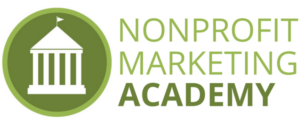When nonprofits approach prospective business partners about sponsoring an event, they usually push two key benefits for sponsoring: the promotional benefits for the sponsor and how the money will positively impact the local community. A third benefit is that it gives businesses the opportunity to engage employees with the community. All of this seems like a win/win, but in actuality, it’s not always.
To get to the root of the challenge, the Academy research team spoke with marketing leads at businesses of all sizes. Here are some compelling reasons why businesses don’t see much benefit.

Smaller businesses have limited discretionary funds. They need to see a good return from their sponsorship investments, so they can keep the doors open.
Let’s start with small businesses. Small businesses generally have little to no discretionary funds in their budgets. Instead, most of the budget goes to payroll, inventory, and operational costs. And depending on how much is spent on these line items, not much is left over for marketing, and even less for community donations. The bottom line is this; the money small business owners do have allocated toward marketing must show a return on the investment, and this is true for event sponsorships too.
A nonprofit sponsorship package legally isn’t supposed to give a business any more promotional benefit than what is given to a donor. When we look at sponsorship opportunities for nonprofit events, most small businesses are more inclined to purchase the low-cost sponsorship opportunities. The IRS limits the type of promotion that sponsors are able to receive, so the low-cost sponsorship levels generally include tactics like a logo and link to the small business website, putting the sponsor logo on a program, or burying the logo along with 10 to 20 other business logos across a banner. Therefore, while your nonprofit fundraising event may bring in 500 to 1000 people, the low-cost sponsorship opportunities don’t generally bring in any revenue or leads for the sponsors. It’s a tough sell.
Now let’s look at midsize to large businesses. These businesses have more discretionary funds, so we naturally think they are more likely to purchase higher level sponsorships. However, that’s not often the case. It is appealing to larger businesses to be able to make a difference in the community, but these businesses also have many nonprofits vying for their donation dollars. So what ends up happening is they tend to help as many nonprofits as possible by purchasing smaller sponsorship levels. On the other hand, when a large business does make a more significant contribution, it’s often to a nonprofit that can generate media exposure, and therefore falls under ‘cause marketing‘. In this case, it’s OK that the nonprofit can only offer limited promotions, because the business’s marketing team can seek media coverage and other significant promotions on their own.

Yoplait’s new Girl Scout themed yogurts generate strong brand awareness for Girl Scouts and revenue for Yoplait.
Cause marketing has grown over the past few decades because consumers are more concerned with social responsibility, and they are drawn to businesses that strive to make a difference, and not just to make money. But make no mistake; the business does get a lot of promotional benefit from it. With cause marketing, we generally see businesses partner with high-profile nonprofits in an effort to choose a cause that will resonate with the majority of their audience.
One example of a big company using cause marketing is Yoplait. For nearly 20 years, Yoplait ran the Lids for Lives campaign to support breast cancer research. Last year, they introduced flavored yogurt featuring the most popular Girl Scout cookie flavors. According to an article in USA Today, similar flavor campaigns have accounted for up to 15 percent of the company’s sales revenue.
So now that you know what you are facing as you are out there trying to secure event sponsors, what can you do to improve your efforts?
IRS Restrictions on Sponsor Promotions
Remember, the IRS limits how nonprofits can promote a sponsor. Below is an overview of what can be offered, according to the councilofnonprofits.org.
- Acknowledgment of name, logo, general phone number, locations, and website in printed media, or on a nonprofit’s website.
- Value-neutral displays of a sponsor’s products or services, free samples of a sponsor’s products at the event. The nonprofit should not endorse the product/service.
- A single internet website link that takes the viewer only to the sponsor’s homepage – not to a page where a product or service is marketed or sold.
If you want to grow your nonprofit sponsorship programs to a high-level revenue stream, you’ll need to shift your thinking. You will need to look at sponsorships more strategically and from a business partner perspective. Shifting your focus will help your nonprofit design events that are mutually beneficial to the sponsor and the nonprofit, but also do not negatively impact your IRS standing.
How to fix the business sponsor challenge
Ask yourself a question. Why do you want to secure more sponsors?
To generate more revenue, right?!
Then, your next step is to modernize your sponsored events and revamp your fundraising strategy. The Nonprofit Marketing Academy has created a free, on-demand training to show you exactly how to do this. It’s called How To Build A High-Revenue Sponsor Program For Your Nonprofit. In just 30-minutes, you will learn how to create a sponsor program that adds value for sponsors and inspires long-term partnerships with sponsors.
How To Build A High-Revenue Sponsor Program For Your Nonprofit. In just 30-minutes, you will learn how to create a sponsor program that adds value for sponsors and inspires long-term partnerships with sponsors.
Key Takeaways:
- A closer look at why sponsors are saying “NO THANKS” to your events
- The most important step for adding value to your sponsor packages
- Examples of modern events that bring sponsors to you




